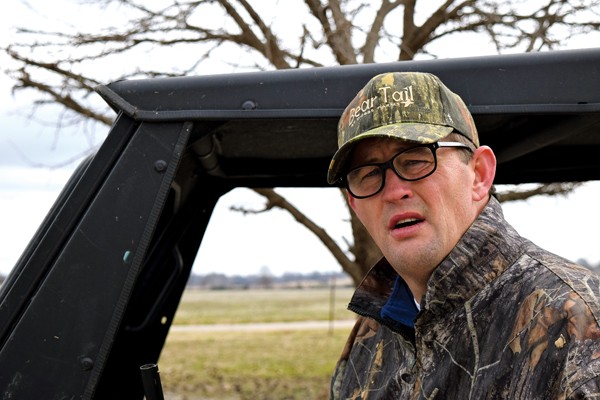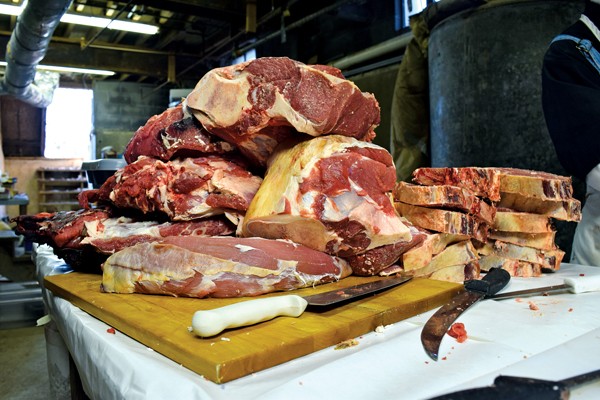When I arrive at Home Place Pastures, they’ve already started the butchery. On the table in front of me lies the steamship round: a 45-pound hunk of meat from below the hip joint on the steer’s hind leg. It’s big and primal, like something a caveman might eat, with a big, white femur bone that pokes out like a trailer hitch.
 John Klyce Minervini
John Klyce Minervini
A hunk of fresh meat being cut from Home Place Pastures.
“That’s a pretty little roast right there,” says one of the men, poking at a bright-red seam of muscle with his wickedly sharp knife. “That’ll feed about 10 people.”
And I thought: What am I doing here?
Okay, back up. According to the USDA, Americans consume about 130 pounds of meat per person, per year. Interestingly, that’s down from a peak of 145 pounds in 2004. (Were we stressed about the Iraq War? Or maybe the final episode of Friends?)
Still, that’s a lot of meat — as of 2012, more than any other country. And the fact remains that most of us have no idea where it comes from. I mean, sure, we know there’s a cow at one end and a hamburger at the other. But what happens in between?
That’s what I set out to find. Because, first, I eat a lot of meat. As a food writer, it’s kind of an occupational hazard. But also, I eat meat when I’m not even really thinking about it. I order bacon with my eggs and ground beef on my nachos. It’s kind of a knee jerk. It’s something I need to work on.
In any case, I figured I owed it to the cows. You know? To actually look one in the eye and watch what happens, start to finish. I wasn’t exactly trying to scare myself into going veg — but, the idea wasn’t completely off the table.
 John Klyce Minervini
John Klyce Minervini
Executive Chef Miles McMath
That’s how I ended up in a pickup truck with Miles McMath, bouncing down a gravel road in Hernando, Mississippi.
“You might wanna hold on,” says McMath, who in my opinion is driving faster than he needs to. “It’s gonna get a little bumpy.”
McMath is the executive chef at St. Jude. Seven years ago, he had the bright idea to start serving restaurant-quality, locally sourced food in a hospital cafeteria, and the whole thing took off. Recently, he was tapped by Southern Living as one of the 50 people who is changing the South in 2015.
He also happens to have a great hookup when it comes to local beef. McMath’s father-in-law keeps a herd of 30 Angus cattle on 60 acres in Hernando. When we drive up, we spot a mother and her newborn calf disappearing into the woods at the edge of the pasture.
“Check that out,” says McMath, pointing, “you can still see the blood on the ground where she gave birth.”
He’s right. The leaves are stained a dark red, and the calf — who hasn’t quite gotten the hang of walking — still has a bit of umbilical cord dangling between his legs.
Unfortunately, I never got to meet the steer we butchered. By the time I heard about him, he had already been hanging on a hook for two weeks. (“Dry-aged” meat is more flavorful and less messy to work with.)
 John Klyce Minervini
John Klyce Minervini
To me, it doesn’t really make sense to say that an animal raised for slaughter is living a “natural” life. That said, these cows seem to have it pretty good. They get up when they want. They eat when they want. Although they are not given antibiotics or synthetic supplements, they do eat a bit of cornmeal for marbling.
“It’s like whisky,” says McMath “You can have a sip every now and then, and you’re not gonna get sick. But you can’t drink a whole fifth. It’s just not gonna work out.”
At the end of his life, our steer was given a bucket of feed. When he lowered his head to eat, McMath shot him between the eyes with a .243 caliber rifle. That may sound awful, but it’s actually calculated to be humane. Proponents say the cow loses consciousness before it can feel any pain.
Still, says McMath, it isn’t easy.
“With our kids,” he admits, absentmindedly patting a steer on the rump, “we got rules about which pigs and chickens you can give a name to. Once you start living with animals, it’s hard to say goodbye.”
 John Klyce Minervini
John Klyce Minervini
Back at Home Place, they’ve nearly wrapped things up. A tidy pile of steaks — rib eye, porterhouse, the kinds of things you might actually find in a grocery store — sits on the table, ready to go. Although the process was a little overwhelming at first, I eventually found it fascinating, in a grim sort of way. The buzzing bandsaw. The enormous ribcage, like something from a dinosaur.
Now there’s just one thing left to do. Before I leave, McMath wraps a New York strip steak in butcher paper and hands it to me. He offers to cook it, but I say no. Because I know that if he does it, it’ll be perfect, and I don’t want it to be perfect.
I want to do this part myself.
Back home, I preheat a cast-iron skillet and rub my steak with kosher salt and cracked pepper. Then I throw it on the stove and let the magic happen. I nearly smoke out the kitchen — and believe it or not, that’s what you’re supposed to do. A very high surface temperature yields a yummy crust and a deep, rich flavor.
After about five minutes, I pull the steak and let it rest. I’ve heard a rumor that grass-fed beef is chewier than grain-fed, and that it has a sharp, astringent flavor. Fortunately, that turns out not to be true. My New York strip is delicate and buttery, as good as anything I’ve had in a restaurant.
I’ll say this: It was different. And not just because of the faint mineral notes I thought I detected in the meat. As I sat at my kitchen table, slowly slicing and chewing, I thought about the calf I’d seen in Hernando, the one who was learning to walk.
Why do we eat meat? Is it because we’ve always done it? How do we justify it — except to say that it tastes good, and we can? I’m not saying it’s wrong — I’m just saying it’s worth thinking about. In the end, every man’s gotta cook his own steak.